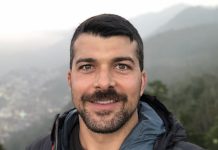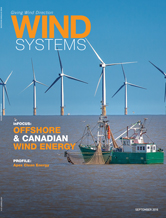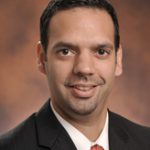Could you give us some background on the National Renewable Energy Laboratory (NREL)?
NREL is a national laboratory that is owned by the U.S. Department of Energy. It’s the only DoE lab that is solely dedicated to the development of renewable energy … wind energy being one of them, and offshore wind being a subset of wind energy.
How did you become involved with NREL?
I came here in 1988. I was previously working as a wind-energy test engineer in California where the wind industry started. It began there because of some lucrative incentives that were sponsored by the state of California as well as the federal government. And most of the industry — including the European industry — began there in California, so when things started to evolve in California, I moved out there, and I worked there for five years, and then came to NREL.
What are the advantages of offshore wind vs. onshore wind?
A lot of it is geographic. Onshore wind — or land-based wind — is available, and it’s very abundant. There are geographic expanses of land where there isn’t a lot of human and environmental conflict. And so we see the development of land-based wind has taken place and taken hold very strongly in the Midwest where there’s a lot of wind. There’s land-based wind that’s evolved in approximately 40 different states. But when you look at the potential for land-based wind to be a large-scale player, the constraints are pretty high when it comes to conflicts with existing human use in high-density population areas.
Offshore wind can circumvent some of those barriers by placing wind turbines off the coast of some of the most populated cities in the country. Large-scale power generation can occur with fairly short transmission lines to population centers.
What are the biggest challenges in building and operating offshore wind farms?
Offshore wind is at a much earlier stage of development. Probably the biggest challenge is getting the costs down. Those costs are high because it’s more expensive in many ways to put a turbine in the ocean where you have to navigate some logistics as well as severe conditions during operation and during installation. So those are the challenges that the industry is facing, but they have made quite a bit of progress on that. That’s in regard to the implementation of the technology.
Explain the process that goes into finding a proper site for an offshore wind farm?
It’s not that different from locating a wind farm on land. The conflicting uses and interference with either environmental or human-use factors are different for offshore than they are on land-based systems. And so they have to be mitigated.
Things that we worry about offshore are physical constraints such as bathymetry (water depth), and making sure there’s enough wind at the sites to begin with to make it economical. But then you get into issues with: Is it going to interfere with sensitive fisheries or marine sanctuaries? Is it going to conflict with aviation or military use? Is it going to interfere with populations that might object to the visual impact of the wind farm? Avian issues are always a concern. They have not been shown to be a bigger issue with offshore wind farms to this date. But there is always something. We have to make sure that we’re not putting turbines in flyways where birds migrate. We worry about marine mammals especially during the construction phase. It’s not as much a siting problem, but it’s more of a procedure you have to follow to avoid conflicts with marine mammals.
There’s always a negotiation and consideration to where the best sites are. And there are two ways you can do that: You can go to the sites that have been pre-selected by the Bureau of Ocean Energy Management (BOEM) — those are the wind-energy areas. Or you do an unsolicited proposal for another site that would have to be vetted through the same process. Everything that BOEM leases on the outer continental shelf has to be done through a competitive-leasing process.
Other than being the first offshore wind farm in the U.S., what makes the Block Island Wind Farm unique?
First of all, they located the five turbines that they’re installing in state waters. So it doesn’t have to go through the federal regulatory process. They’re off the southeast coast of Block Island. They don’t have a huge amount of visual impact on the island, but there are some houses that are going to be looking right at them. The other thing is that just a small fraction of the energy coming from one of the turbines will power the entire island. So they’re bringing the power from the wind farm to the island, and they connected Block Island by cable to the mainland. So those wind turbines will power all of Block Island, and they’re going to be supplying power to the southern part of Rhode Island as well.
What challenges has the U.S. experienced in its pursuit of offshore wind?
The U.S. has been pursuing offshore wind opportunities since 2001. Cape Wind put in their first proposal back in 2001. And it came about because interest was generated by the Europeans going to commercial offshore wind farms back in the same timeframe. So, since Cape Wind began — and they really were the pioneers for the U.S. development — there’s been a process underway and evolving, and it has taken a lot of time because there’s a lot of bureaucracy creating a whole regulatory framework for a whole new technology that includes the entire outer continental shelf.
And I think also, there’s been a lot of cost volatility that made the price of offshore wind farms uncertain over the last decade. Projects have been located in challenging sites, and issues and uncertainties with the logistics of installing turbines have had a disparity between the estimated cost and the actual cost over the first few projects. I think now that the project costs are much more well-known and there’s a European supply chain and the risks have gone down, the costs have started to come down. I think we’re going to see that the U.S. market is going to take advantage of that and start to emerge.
Can you explain floating wind and its advantages?
Floating wind takes advantage of resource areas that are in deeper water. And that means you don’t need a foundation that goes all the way to the seabed. They’re floating on buoyant foundations that are moored to the seabed. They’re less dependent on exact water depth and bathymetry, and that generally opens up about 60 percent more resource area. It more than doubles the amount of area that’s available for offshore wind development if you can get the cost of this technology down at least comparable to the fixed-bottom option. So to do that there’s a lot of technology development that’s needed, and it’s at a much earlier stage of development than the fixed-bottom systems.
Can you share a bit of what we can expect from your panel at AWEA Offshore Windpower 2016?
My panel brings together four of the leading technology developers of floating technology that are active in the United States. And we’re going to have a good discussion about the state of that technology and the opportunities that floating wind turbines present.
Is NREL involved in other future offshore wind projects?
We like to be connected to industry partners and to get experience in the field. But our main mission is to try to be a little bit out in front of the industry and try to anticipate issues that maybe the industry is not facing today but may be facing 10 years from now.
But we’ve been doing work with the Aqua Ventus project in Maine, which is a pilot project that’s being sponsored by the Department of Energy. It’s a public/private partnership that will possibly put in the first full-scale turbine in the United States and that’s scheduled — if it goes forward — to be put in in 2018.
We have been involved in several of the other advanced technology demonstration projects that the DoE has been sponsoring. Fishermen’s Energy is putting a pilot project near Atlantic City. They’re waiting to get approvals for that project, and that’s part of their program as well.
We’ve been working very closely with the Bureau of Ocean Energy Management — which has jurisdiction to the outer continental shelf — and helping them cultivate the regulatory regime and the regulatory space and mature that process, so it’s ready for commercial development.
![]() (303) 384-6956
(303) 384-6956
![]() www.nrel.gov
www.nrel.gov
![]() /nationalrenewableenergylab
/nationalrenewableenergylab
![]() @nrel
@nrel
![]() NRELPR
NRELPR
![]() national-renewable-energy-laboratory
national-renewable-energy-laboratory








































